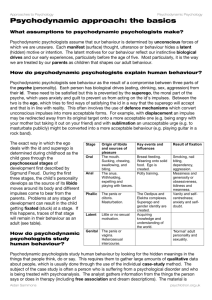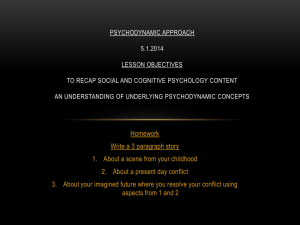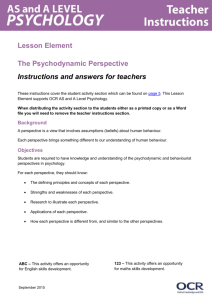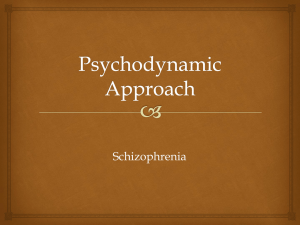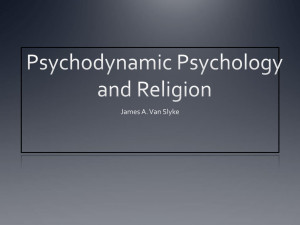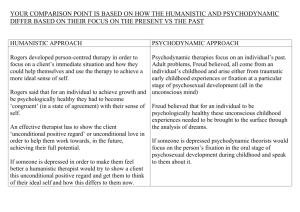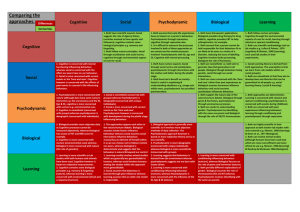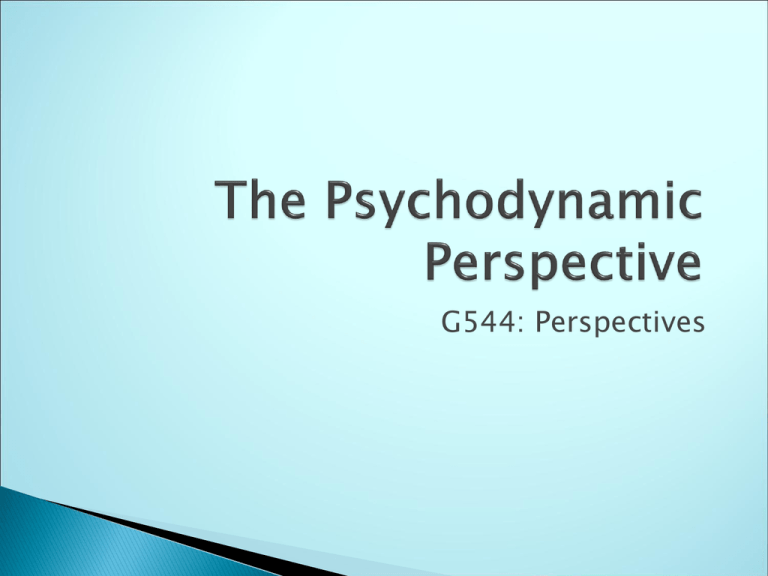
G544: Perspectives
I used hypnotism to
treat patients
I was a Mechanist
I am Austrian
I worked alongside
the leading neuroscientists of the day
I worked alongside
Charcot
I wrote a paper on
“Male Hysteria”
Assumptions of the psychodynamic
approach
• Much of our behaviour is driven by
unconscious motives
• Childhood is a critical period in
development
• Mental disorders arise from unresolved,
unconscious conflicts originating in
childhood
• Resolution occurs through accessing and
coming to terms with repressed ideas
and conflicts
Task 1.
Read the sheet – boxes 1 to 4.
Stop before ‘mental imbalances’
In pairs create 4 questions to which the
answer is “Freud”. 1 per box.
E.g. “Who was an Austrian-Jewish
Psychologist from Vienna?
A: SIGMUND FREUD!
5 minutes! Go!
Consolidation
Id: Pleasure principle
Superego: Morality
principle
Ego: Reality principle
Conscious: The part of the
mind we are aware of –
everyday thoughts and
feelings
Preconscious: Thoughts
and memories not
accessible at all times, but
easily recalled
Unconscious: The deep
dark shameful part!
Repressed thoughts,
memories and feelings
Okay, okay
guys, look
we’ll sort
something
out. Sheesh!
We’d better
not, we
don’t want
to get fat!
FEEED
MEEE
NOWWW!!!
ARRRRGH!
Another way to think about it…
Yeah, but when are
we eating!?!
Oh my
Gahd
Rachel!
Oh my
Gahd
dinosaurs
!
Oh my
Gahd
etc…
EGO
Superego
ID
Hey you
guys….
smart-alec
comment
etc….
Task 2
10 minutes! Go!
Read through Sources of abnormality 1 and 2
Create 5 summary cards
1. Outline Freud’s theory of mind.
2. Describe how mental
imbalances cause abnormality
3. Give example of a mental
imbalances abnormality.
4. Describe the defence
mechanism idea.
5. Give an example of a Defence
mechanism abnormality.
Extension.
If you finish, on the back of
cards 1, 2 and 4 evaluate
the theory:
•Pros and cons.
•Do you ‘buy’ it?
•Why?
•Assumptions?
Personality Summary
[Mental imbalances]
• Ego too weak – allows id and superego
to dominate
• Id too strong – selfish, out of control,
could become psychopathic
• Superego too strong – strict, anxious,
obsessive – depression, anxiety, OCD
• How might bipolar disorder be
explained using this approach?
Defence mechanisms
• The constant disagreements between the
id, the ego and the superego can lead to a
lot of anxiety
• E.g. You want that bar of chocolate but
you know you’re meant to be on a diet – you
feel guilty if you have it but unsatisfied if
you don’t – anxiety either way!
• So the mind develops various methods of
defending itself – for example you tell
yourself that it’s ok to eat the chocolate
because it’s good for you (rationalisation)
• We all use defence mechanisms on a daily
basis
• They are unconscious – we aren’t aware of
what we’re doing
• But… if we over use them they can lead to
mental abnormalities – psychosis?
• Denial: You completely reject the
thought or feeling
My Ashley would
never cheat on me…
• Projection: You attribute your own
socially unacceptable thought or
feeling to someone else
I can’t believe what Vernon
Kay has been up to… what
a cheating liar! How could
he do that to his beautiful
wife?
• Suppression: You are vaguely aware of
the thought or feeling, but try to hide
it.
Hmmm, perhaps Ashley
isn’t as perfect as I
thought. Can’t think
about that now… got to
go and buy some new
shoes instead.
• Displacement: you redirect your
feelings to another target
It’s not my fault my marriage
is over. It’s the newspapers’.
And those women for selling
their stories… And Cheryl’s
for not being there enough…
And my mum’s for not
breastfeeding me. I hate
them all!
‘m to an old,
• Regression: You revert
usually immature, behaviour
I’m going home to me Mam,
so she can cook me beans
on toast, and stroke me
hair and tell me that
everything is going to be
alreet.
• Sublimation: You redirect the feeling
into a socially productive activity e.g.
art, poetry, sport
I’m going to make
another album, and learn
how to tap dance, and
take up scuba diving!
• Rationalisation: You try to justify
uncomfortable thoughts or feelings
with socially acceptable motives
I don’t hate women… I
love them… that’s why
I can’t keep it in my
pants!
• Reaction formation: You turn the
feeling into its opposite
I’m not at all upset or
humiliated. In fact, I’m
the happiest I’ve ever
been.
Psychosexual stages
• Freud believed that children
are born with a libido – a
sexual (pleasure) urge
• There are a number of stages of childhood,
during which the child seeks pleasure from a
different ‘object’
• To be psychologically healthy, we must
successfully complete each stage
• Mental abnormality can occur if a stage is
not completed successfully – the person
becomes ‘fixated’
The oral stage
• Birth to 18 months approximately
• The mouth is the main focus of pleasure during
this stage
• The child enjoys tasting and sucking
• Successful completion of this stage is
demonstrated by weaning – eating
independently
• Oral receptive (not allowed to suck freely) –
passive, needy, sensitive to rejection – overeats
and drinks, bite nails, may smoke
• Oral aggressive (allowed to suck too often/too
long) – hostile and verbally abusive, sarcastic
The anal stage
• 18 months to 3 years
• Defecation is main source of pleasure
• Successful completion marked by potty
training
• Anally retentive - very tidy, stubborn,
likes order and being in control
• Anally expulsive - generous but
disorganised , doesn’t like to follow rules
The Oedipus complex
• Occurs during the phallic stage
• Around age 3-5
• Boy wants his mother as his ‘primary
love object’
• Wants his father out of the way
• Fears that his father knows this and
will castrate him as punishment
• Identifies with father to stop
castration anxiety
The Electra (female Oedipus)
complex
• A girl also desires her mother
• But she realises she doesn’t have a penis like her
father!
• Becomes hostile towards her mother because
she believes her mother has castrated her
• Develops attraction to father instead because
she believes he can give her a baby, which will
act as a penis substitute
• Eventually resolves feelings
towards mother and identifies
with her – doesn’t want to lose
her mother’s love
The latency stage
• Age 6 to puberty approximately
• Sexual urges sublimated into sports
and other hobbies
• Focus on developing same sex
friendships
• No particular requirements for
successful completion
• Lull before the storm of puberty!
The genital stage
• Puberty into adulthood
• Focus on genitals but not
to same extent as phallic
stage
• Task is to develop healthy
adult relationships
• This should happen if
earlier stages have been
negotiated successfully
• Old Age Pensioners Love Guinness!
•
•
•
•
•
Oral stage
Anal stage
Phallic stage
Latent stage
Genital stage
Stage
Oral
Age Range
0-1 years
Erogenous zone(s) Consequences of Fixation
Mouth
Orally aggressive: Signs include chewing gum
or ends of pens.
Orally Passive: Signs include smoking/eating.
Fixation at this stage may result in passivity,
gullibility, immaturity and manipulative
personality
Anal retentive: Obsession with organization or
excessive neatness
Anal expulsive: Reckless, careless, defiant,
disorganized, Coprophiliac
Oedipus complex (in boys only according to
Freud)
Electra complex (in girls only, later developed
by Carl Jung)
Anal
2-3 years
Bowel and bladder
elimination
Phallic
4-6 years
Genitals
Latency
7-10 years
Dormant sexual
(until puberty) feelings
(People do not tend to fixate at this stage, but if
they do, they tend to be extremely sexually
unfulfilled.)
Genital
11+ years
Sexual interests
(Puberty and
mature
beyond)
Frigidity, impotence, unsatisfactory relationships
The Oedipus Complex
Oedipus (taken from the Greek
tragedy), killed his Father &
married his Mother.
The child becomes aware of
anatomical sex differences. Boys
& girls both go through this
conflict, however Freud
concentrated mostly on boys
resolving the conflict.
Girls resolve the conflict known as
the Electra complex.
It is very difficult to test the theory of
unconscious motivation – whatever is
not remembered can be said to be
repressed – this is non-falsifiable.
The case study method utilises
unrepresentative samples and
therefore there are concerns about
generalisability
The clinical (therapeutic) interview
method has problems with bias and
there has been accusations of
implanting false memories by
therapists leading to reconstructed
memories.
The psychodynamic perspective has
enormous explanatory power for
both normal and abnormal
behaviour.
Practical applications: it has had a
huge impact on the world of
counselling, psychotherapy and
psychiatry.
The idea of the motivated
unconscious has had a huge impact
on Western thought and literature.
It treats the whole person, not just
the problem.
Strengths & Limitations
Strengths
Reflects the complexity of
human behaviour
It can be used to explain a
wide range of behaviour. In
fact, many supporters of this
perspective would argue that
it can be used to explain all
behaviour.
It has been incredibly
influential in therapy and the
use of psychodynamic-based
therapies is still widely used
today.
Limitations
It is highly subjective and it is
extremely hard, if not
impossible, to test its ideas
scientifically.
It makes generalisations
about human behaviour
based on small and often
atypical samples. E.g. Case
study of Little Hans used to
confirm the idea of an
Oedipus complex that all
boys are said to go through.
Similarly to the first
weakness, some of the tests
used are subjective and
unreliable. E.g. The
Rorschach inkblot test
Free will vs determinism
• Determinism is the belief that everything –
including human thought and behaviour – is
predetermined by the law of nature (fate,
God, evolution, etc.)
• Free will is the belief that we have total
control over our own lives
• Psychodynamic theory is deterministic
because it states that behaviour is
controlled by the unconscious mind –
something we don’t have control of
Usefulness
A main strength of the psychodynamic perspective is the way it
can be used to explain a wide variety of phenomenon. In fact
some followers of the psychodynamic perspective believe that all
human life can be explained from a psychodynamic approach.
However, you will find even more psychologists who argue that
the psychodynamic theory cannot explain anything.
One of the many criticisms of the psychodynamic perspective is
that is highly subjective and its ideas are hard to test
scientifically. For example, most of the ideas are based on case
studies of individuals and are not easily tested experimentally.
Furthermore the psychodynamic approach does make many
generalisations based on these case studies of individuals.
Evaluation of the
psychodynamic approach to
psychopathology
1. Influential
2. Unscientific – how
can it be tested?
3. Retrospective data
– case studies
4. Doesn’t consider
adult experiences
5. Blames parents!
6. Deterministic
• Is it a strength or a
limitation?
• Is there any
evidence to support
this point?
• Is there a counterargument? How
might Freud have
defended himself?
Comparison
Psychodynamic
Physiological
The psychodynamic approach
Physiological psychology focuses on
the relationship between our
biological makeup and our
behaviour and experiences.
suggests that our adult personality and
behaviour are determined by our
childhood experiences.
behaviour can be explained in terms
of the inner conflicts of the mind.
Freud believed that the unconscious
mind determines much of our
behaviour and that we are motivated
by unconscious emotional drives.
Freud believed that the unconscious
contains unresolved conflicts and has
a powerful effect on our behaviour and
experience.
They are reductionists saying that
behaviours and experiences can be
explained in terms of brain
structure and chemicals.
For example, the study by Raine
(1997) attempts to investigate the
relationship between brain
structure and function and violence.
Possible Section B Questions
a. Using your knowledge of psychology, briefly outline the Psychodynamic
perspective. (4 marks)
b. Describe two pieces of psychological research that use the
Psychodynamic perspective. (8 marks)
c. Discuss the strength and limitations of the Psychodynamic perspective
to explain behaviour. Use examples of psychological research to
support your answer. (12 marks)
d. Compare the Psychodynamic perspective with the Physiological
approach in psychology using examples of psychological research to
support your answer. (8 marks)
e. Discuss how the Psychodynamic perspective can help our
understanding of everyday life. (8 marks)


